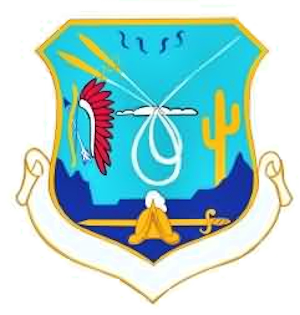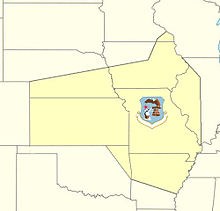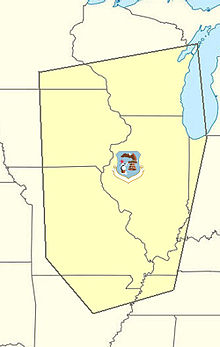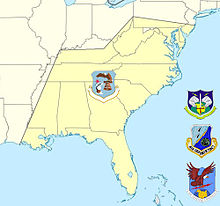
The 28th Air Division is an inactive United States Air Force organization. Its last assignment was with Air Defense Tactical Air Command at Tinker Air Force Base, Oklahoma. It was inactivated on 29 May 1992.

The 33rd Air Division is an inactive United States Air Force organization. Its last assignment was with Air Defense Command, assigned to First Air Force, being stationed at Fort Lee Air Force Station, Virginia. It was inactivated on 19 November 1969.

Fortuna Air Force Station is a closed United States Air Force General Surveillance Radar station. It is located 4.2 miles (6.8 km) west of Fortuna, North Dakota. It was closed in 1979 as a radar station, remaining as a Long-Range Radar (LRR) facility until 1984.

The Spokane Air Defense Sector (SPADS) is an inactive United States Air Force organization. Its last assignment was with the Air Defense Command 25th Air Division at Larson Air Force Base in Grant County, Washington

The Detroit Air Defense Sector (DEADS) is an inactive United States Air Force organization. Its last assignment was with the Air Defense Command (ADC) 26th Air Division at Custer Air Force Station (AFS), Michigan. It was inactivated on 1 April 1966.

The Washington Air Defense Sector (WaADS) is an inactive United States Air Force organization. Its last assignment was with the Air Defense Command (ADC) 26th Air Division, being stationed at Fort Lee Air Force Station (AFS), Virginia. It was inactivated on 1 April 1966.

The Syracuse Air Defense Sector (SADS) is an inactive United States Air Force organization. Its last assignment was with the Air Defense Command (ADC) 26th Air Division at Hancock Field, New York.
The 4731st Air Defense Group is a discontinued United States Air Force organization. Its last assignment was with the 64th Air Division of Air Defense Command (ADC) at Ernest Harmon Air Force Base, Newfoundland, Canada, where it was inactivated in 1960. The group was formed in 1957 when ADC assumed responsibility for air defense of Newfoundland from Northeast Air Command and controlled a fighter-interceptor squadron at Harmon and two squadron operating radars at dispersed locations. It was discontinued when Goose Air Defense Sector assumed responsibility for air defense of Newfoundland.

The Oklahoma City Air Defense Sector (OCADS) is an inactive United States Air Force organization. Its last assignment was with the Air Defense Command's 29th Air Division at Oklahoma City Air Force Station, Oklahoma.

The Chicago Air Defense Sector (CADS) is an inactive United States Air Force organization. Its last assignment was with the Air Defense Command (ADC) 30th Air Division at Truax Field Wisconsin. It was inactivated on 1 April 1966.

The Albuquerque Air Defense Sector (AADS) is an inactive United States Air Force organization. It was briefly active between 1 January and 1 November 1960, assigned to the 33d Air Division at Kirtland Air Force Base, New Mexico. The sector was responsible for the air defense of New Mexico and most of Texas, and was inactivated as a result of a shift towards ballistic missile defense.

Charleston Air Force Station is a defunct Air Force Station that opened in 1952 and closed in 1980. It was located in Charleston, Maine and is the site of a radar station and other buildings. After closure, it was redeveloped into a juvenile jail for the state of Maine.

Calumet Air Force Station is a closed United States Air Force General Surveillance Radar station. It is located 5.2 miles (8.4 km) east-northeast of Phoenix, Michigan. It was closed in 1988 by the Air Force, and turned over to the Federal Aviation Administration (FAA).
Bedford Air Force Station is a closed United States Air Force General Surveillance Radar station. It is located 12.7 miles (20.4 km) north of Bedford, Virginia. It was closed in 1975.
Palermo Air Force Station is a closed United States Air Force (USAF) General Surveillance Radar station. It was located in Palermo, New Jersey, 4.8 miles (7.7 km) north of Sea Isle City, in Cape May County, New Jersey, United States. It was closed in 1970.

Baudette Air Force Station is a closed United States Air Force General Surveillance Radar station. It is located 3.1 miles (5.0 km) south-southwest of Baudette, Minnesota. It was closed in 1979.

Havre Air Force Station is a Formerly Used Defense Site that was used as a Cold War general surveillance radar station. In addition to radar facilities and a NORAD Control Center the site had support services: NCO club, bowling alley, hobby shops, library, movie theater, barber shop, exchange, commissary, grade school, and housing for officers and senior NCOs.

Mount Laguna Air Force Station is a closed United States Air Force General Surveillance Radar station. It is located 24.3 miles (39.1 km) north-northeast of Tecate, California. It was closed in 1981 by the Air Force, and turned over to the Federal Aviation Administration (FAA).

Condon Air Force Station is a closed United States Air Force General Surveillance Radar station. It is located 5.7 miles (9.2 km) west of Condon, Oregon. It was closed in 1970.
Othello Air Force Station is a closed United States Air Force General Surveillance Radar station. It is located 7.2 miles (11.6 km) south of Othello, Washington. It was the home station of the 637th Aircraft Control and Warning Squadron and the 637th Air Defense Group, closing in 1975.























